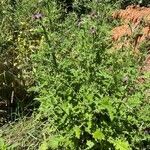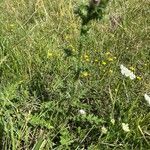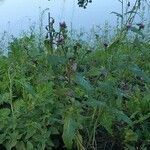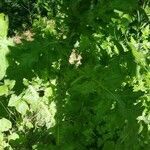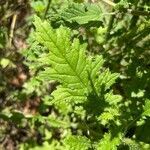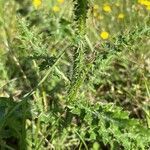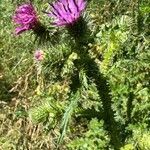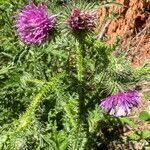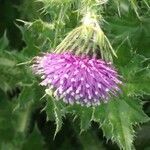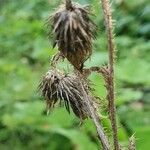Annuals or biennials, 30–150 cm. Stems openly branching, villous with curled, septate hairs to nearly glabrous, spiny wings to 1.5 cm wide, wing spines to 3 mm. Leaves: basal tapering to winged petioles, blades 10–20 cm, margins spiny-toothed to ± shallowly pinnately lobed; cauline sessile, gradually smaller, margins often more deeply divided, marginal spines to 3 mm; abaxial leaf faces ± tomentose with long, one-celled hairs and/or long, curled, septate hairs along veins or glabrate; adaxial faces sparsely hairy or glabrate. Heads borne singly or in groups of 2–5, 15–18 mm. Peduncles spiny-winged to near apex or throughout, to 4 cm. Involucres ± spheric, 12–17 × 12–17 mm. Phyllaries narrowly lanceolate, outer and middle with appressed bases ca. 1 mm wide and appressed to spreading appendages 0.5–1 mm wide, spine tips 1–1.5 mm, inner with unarmed, straight tips. Corollas purple or ± white, 11–16 mm, lobes ca. 3.5 times length of throat. Cypselae light brown to gray-brown, 2.5–3.8 mm; pappus bristles 11–13 mm. 2n = 16 (Sweden).
Biennial, 6-20 dm, rather weakly spiny, the stem brittle; lvs broader and less deeply cleft than in no. 2 [Carduus acanthoides L.], cottony-tomentose beneath at least when young; heads clustered at the ends of the often short branches, similar to those of no. 2, but less pungent and avg a little smaller, the invol 1.2-1.7 cm; peduncles often wingless in the distal several mm; 2n=16. Roadsides and waste places; native of Eurasia, sparingly intr. in our range, chiefly about the larger ports. June-Sept.
An annual herb. It is a thistle. It grows 1.5 m high and spreads 1 m wide. The stem is erect and winged. It has spines. The leaves are narrow and have lobes. They are prickly. There are prominent veins underneath. The flowers are small and purple. There are 3 or 4 clustered together.
